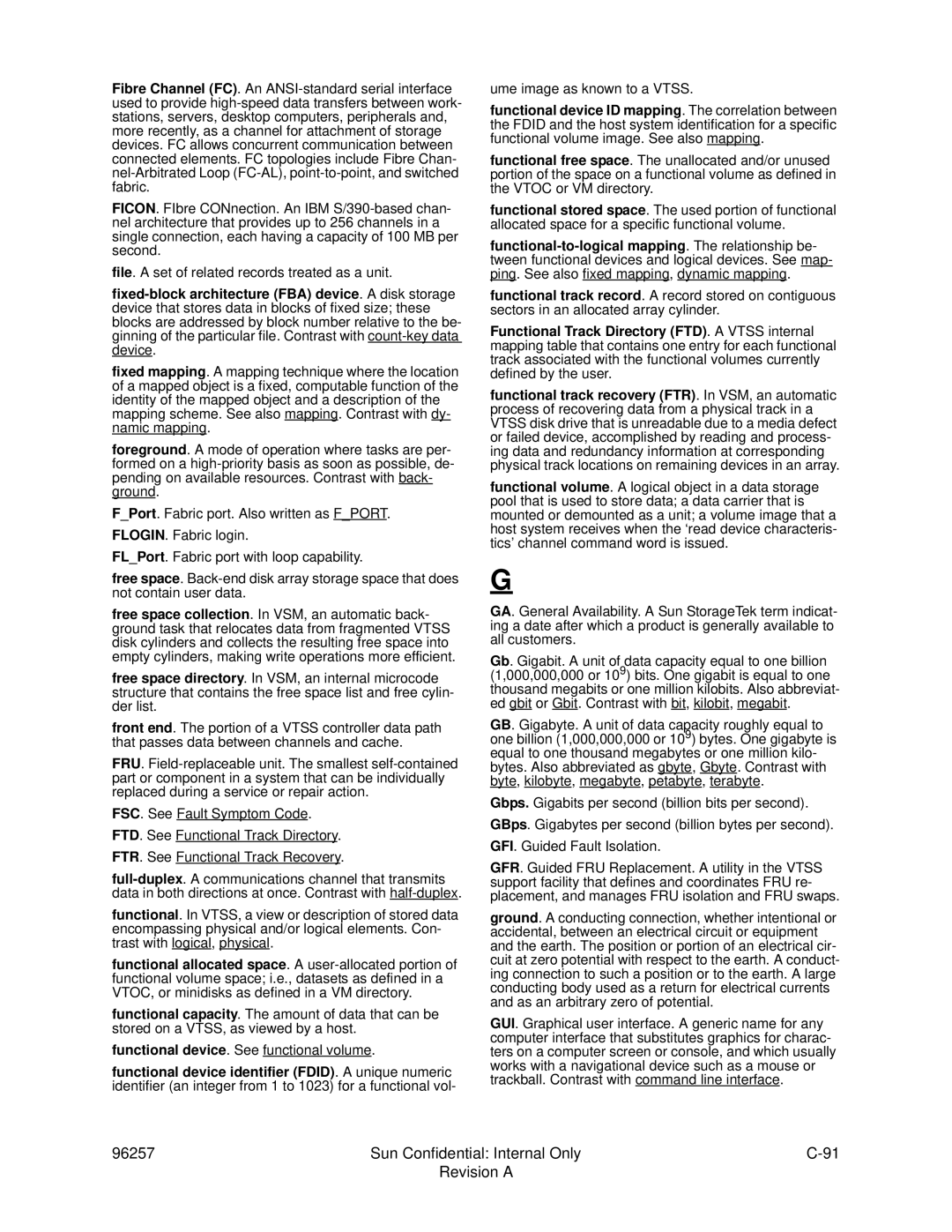Fibre Channel (FC). An
FICON. FIbre CONnection. An IBM
file. A set of related records treated as a unit.
fixed mapping. A mapping technique where the location of a mapped object is a fixed, computable function of the identity of the mapped object and a description of the mapping scheme. See also mapping. Contrast with dy- namic mapping.
foreground. A mode of operation where tasks are per- formed on a
F_Port. Fabric port. Also written as F_PORT. FLOGIN. Fabric login.
FL_Port. Fabric port with loop capability.
free space.
free space collection. In VSM, an automatic back- ground task that relocates data from fragmented VTSS disk cylinders and collects the resulting free space into empty cylinders, making write operations more efficient.
free space directory. In VSM, an internal microcode structure that contains the free space list and free cylin- der list.
front end. The portion of a VTSS controller data path that passes data between channels and cache.
FRU.
FSC. See Fault Symptom Code.
FTD. See Functional Track Directory.
FTR. See Functional Track Recovery.
functional. In VTSS, a view or description of stored data encompassing physical and/or logical elements. Con- trast with logical, physical.
functional allocated space. A
functional capacity. The amount of data that can be stored on a VTSS, as viewed by a host.
functional device. See functional volume.
functional device identifier (FDID). A unique numeric identifier (an integer from 1 to 1023) for a functional vol-
ume image as known to a VTSS.
functional device ID mapping. The correlation between the FDID and the host system identification for a specific functional volume image. See also mapping.
functional free space. The unallocated and/or unused portion of the space on a functional volume as defined in the VTOC or VM directory.
functional stored space. The used portion of functional allocated space for a specific functional volume.
functional track record. A record stored on contiguous sectors in an allocated array cylinder.
Functional Track Directory (FTD). A VTSS internal mapping table that contains one entry for each functional track associated with the functional volumes currently defined by the user.
functional track recovery (FTR). In VSM, an automatic process of recovering data from a physical track in a VTSS disk drive that is unreadable due to a media defect or failed device, accomplished by reading and process- ing data and redundancy information at corresponding physical track locations on remaining devices in an array.
functional volume. A logical object in a data storage pool that is used to store data; a data carrier that is mounted or demounted as a unit; a volume image that a host system receives when the ‘read device characteris- tics’ channel command word is issued.
G
GA. General Availability. A Sun StorageTek term indicat- ing a date after which a product is generally available to all customers.
Gb. Gigabit. A unit of data capacity equal to one billion (1,000,000,000 or 109) bits. One gigabit is equal to one thousand megabits or one million kilobits. Also abbreviat- ed gbit or Gbit. Contrast with bit, kilobit, megabit.
GB. Gigabyte. A unit of data capacity roughly equal to one billion (1,000,000,000 or 109) bytes. One gigabyte is equal to one thousand megabytes or one million kilo- bytes. Also abbreviated as gbyte, Gbyte. Contrast with byte, kilobyte, megabyte, petabyte, terabyte.
Gbps. Gigabits per second (billion bits per second). GBps. Gigabytes per second (billion bytes per second). GFI. Guided Fault Isolation.
GFR. Guided FRU Replacement. A utility in the VTSS support facility that defines and coordinates FRU re- placement, and manages FRU isolation and FRU swaps.
ground. A conducting connection, whether intentional or accidental, between an electrical circuit or equipment and the earth. The position or portion of an electrical cir- cuit at zero potential with respect to the earth. A conduct- ing connection to such a position or to the earth. A large conducting body used as a return for electrical currents and as an arbitrary zero of potential.
GUI. Graphical user interface. A generic name for any computer interface that substitutes graphics for charac- ters on a computer screen or console, and which usually works with a navigational device such as a mouse or trackball. Contrast with command line interface.
96257 | Sun Confidential: Internal Only | |
| Revision A |
|
